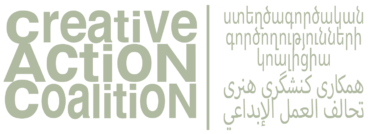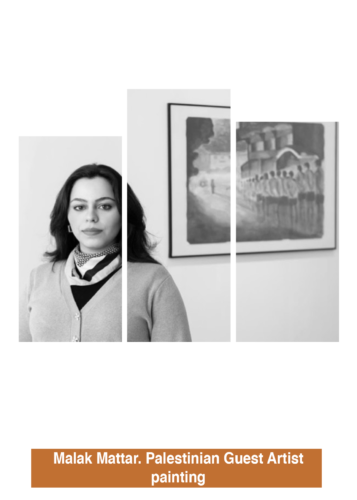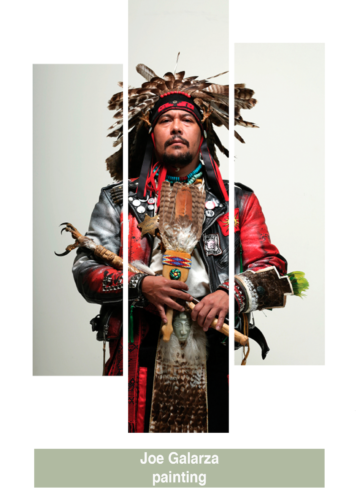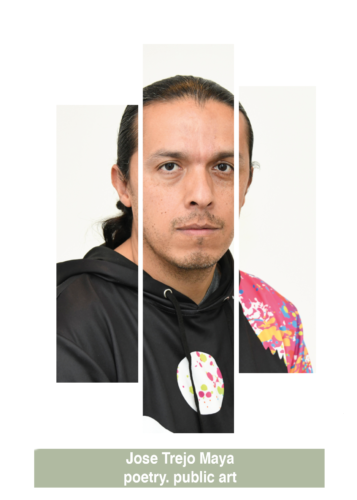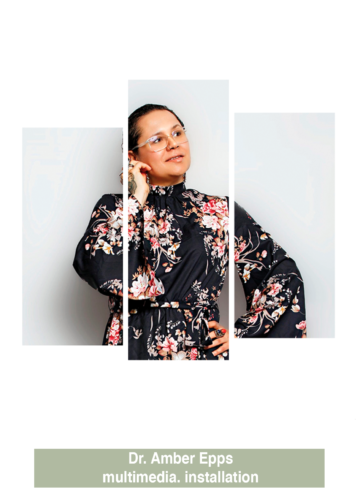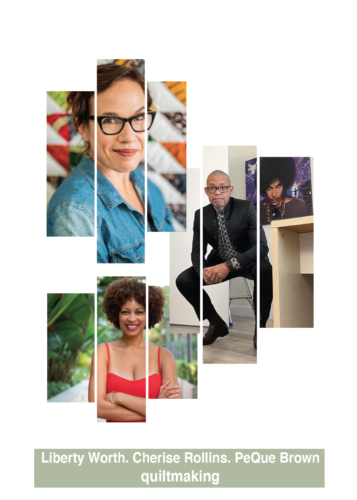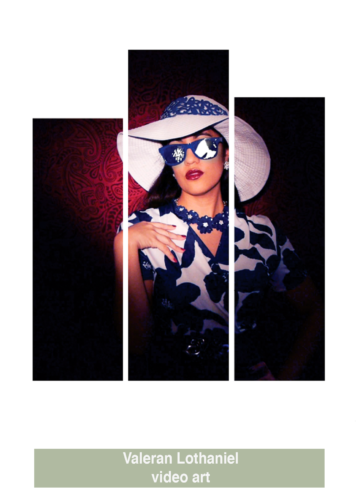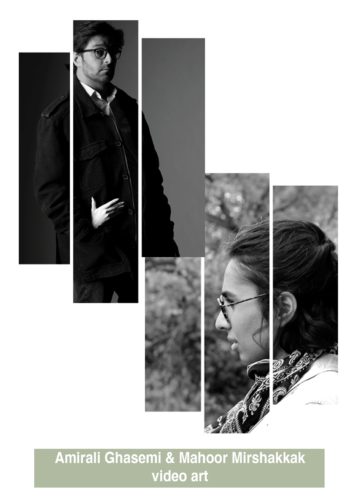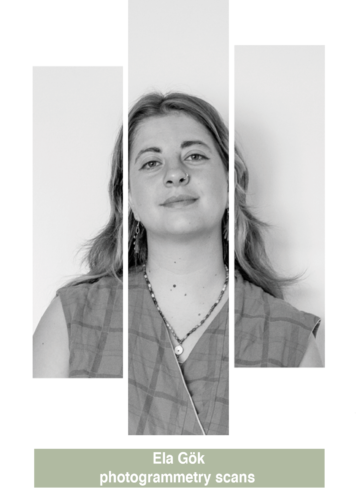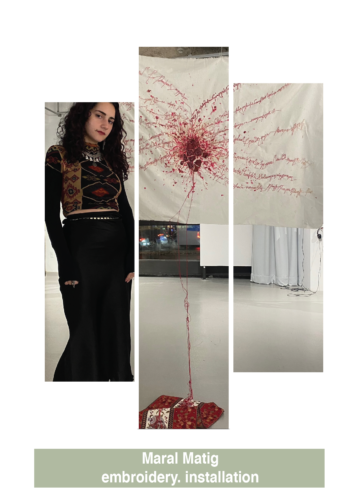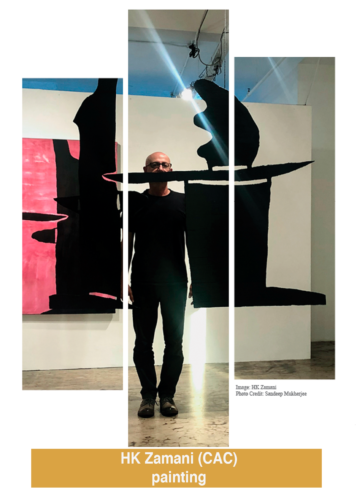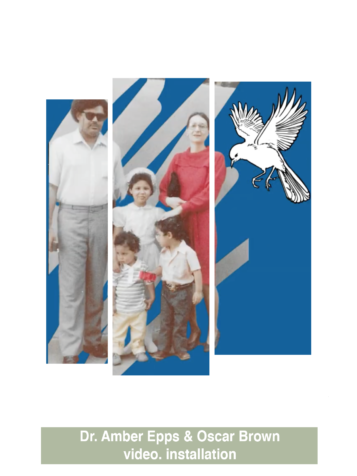COGS IN THE MACHINE: BREAKING THE MECHANISMS OF OPPRESSION
ONLINE EXHIBITION
APRIL 11, 2024 — runs indefinitely
Acknowledgements:
- Catalog, website, introductory essay for the catalog by Alysse Stepanian.
- Special thanks to all the participating artists.
- Artists retain the copyright to their own work.
- All images are courtesy of the artists, unless otherwise noted.
Cogs in the Machine presents a selection of works from proposals that Creative Action Coalition (CAC) has received in response to a call for artists to share their work about the nature of colonialism, displacement, and social oppressions that they might have experienced on a personal level.
PARTICIPATING ARTISTS
Brick color tag: Palestinian guest artist, Malak Mattar.
Green tags: Selected artists from proposals received.
Orange tags: Creative Action Coalition (CAC) Members.
(click on the artist portraits or the links below)
PALESTINIAN GUEST ARTIST
Malak Mattar (painting)
SELECTED PROPOSALS
Joe Galarza (painting)
Jose Trejo Maya (poetry. public art)
Jennaya Dunlap (painting)
Dr. Amber Epps & Oscar Brown (video. installation) — WATCH VIDEO
Dr. Amber Epps (multimedia installation)
Liberty Worth. Cherise Rollins. PeQue Brown (quiltmaking)
Valeran Lothaniel (video art) — WATCH VIDEO
Amirali Ghasemi & Mahoor Mirshakkak (video art) — WATCH VIDEO
Ela Gök (photogrammetry scans)
Maral Matig (embroidery. installation)
WORK BY CAC MEMBERS
Alysse Stepanian (video art. music. performance) — WATCH VIDEO 1 ; VIDEO 2
HK Zamani (painting)
Massa Lemu & Ozhopé Collective (performance. video art) — WATCH VIDEO
Srboohie Abajian (digital posters)
Zaven Ovian (poetry)
PALESTINIAN GUEST ARTIST
Malak Mattar
London (England)
Instagram:@malakmattarart
Malak was born in 1999 in the Gaza Strip and grew up under occupation and the military siege. From a family of talented cultural practitioners, Mattar started making art as a teenager during a period of open conflict (Operation Protective Edge, 2014), and she soon began to sell work online and exhibit internationally. She won a scholarship to study political science at Istanbul Aydin university (2018–22) and another to study a Masters of Fine Art at Central Saint Martin’s, London, in 2023.
Soon after arriving in the UK, Mattar’s entire world was turned upside down, causing her work to undergo a dramatic shift in style, subject matter and palette. While artist-in-residence at An Effort in Central London (December 2023–February 2024), she documented the genocide in her homeland through a series of mostly monochrome drawings and paintings. She later combined these scenes into a monumental greyscale painting called No Words [see next page]. Mattar wrote and illustrated the bestselling children’s book Sitti’s Bird (2021) based on her own life experiences, which is already in its second print run. In defiance of strict travel restrictions, Mattar has lectured in universities across the USA (2020–21) and she has had solo exhibitions in Palestine (2015 onwards); Costa Rica (2015); Great Britain (2017, 2018, 2023, 2024); Sweden (2018); USA (2019, 2021); Germany (2020); Lebanon (2021); Portugal (2022) and Italy (2022). Most recently, Malak had two concurrent exhibitions in London, and her monumental painting No Words was shown for the first time (March 2024). Her artworks have also been collected, published, and exhibited in numerous group shows worldwide.
(Profile photo credit: Sarah Booker)
 Joe Galarza
Joe Galarza
Los Angeles, Turtle Island (USA)
Instagram:@geneticwindsongs
My colonized name is Joe Galarza, my Indigenous name is Pepeyotl which means ‘One who Gathers Medicine’. I am a painter, muralist, sculptor, ceramicist, musician, and arts educator from El Sereno, Los Angeles and I use art as a decolonizing tool. My roots are Penatuka Numunu Comanche/Tepehuan Odam Nations.
I am informed by my experience documenting indigenous oral histories through mural, working with indigenous communities in California and the US through close collaboration with oral storytellers. In 1989, as I became involved in a fight to defend Navajo elders being forcibly relocated, I heard a phrase that has always stuck with me– “relocation is genocide”– a form of ethnic cleansing to eliminate a people who have been on the land for thousands of years, whose umbilical cords are buried there, literally connecting them to it.
I have taught art and muralism at juvenile halls for 27 years now. I teach young men not only about the importance of art but also what it means to be indigenous. I incorporate my native spirituality through song and ceremonial practices that work towards healing intergenerational trauma. I notice a change in some of the young men when they learn about these traditions.
Prey
Left Image: 2004. 5’x 6’ . Oil on Canvas
The impact of Colonization on indigenous communities is still present through the trauma and poverty of the boarding school system. But the survivors continue to live and work towards decolonization and empowerment. The countless victims throughout history show the world’s dysfunction. The abuse was so severe that our language and cultural practices were hidden to preserve our history and relationship with Mother Earth. They stand to watch, doing nothing against abuse and injustice, preying upon a population. But we are resilient to strive for our future generations. Free Big Mountain, Standing Rock, Cheran and 530 years of indigenous resistance.
Pipeline NDN
Right image: 2018. 5’x 6’ . Oil on Canvas
This piece highlights how we are in a time where Native people throughout the world are fighting for land preservation against colonial violence, to exist in relationship with Mother Earth, and to walk in beauty for our future generations against repression and oppression. Our spiritual prayer is for the water that gives us life and for all living creatures. We fight for the right to be human as no treaty has ever been honored. We are in a struggle for human existence in a time of genocide of Indigenous Palestinians. We fight with art as a weapon for true justice.
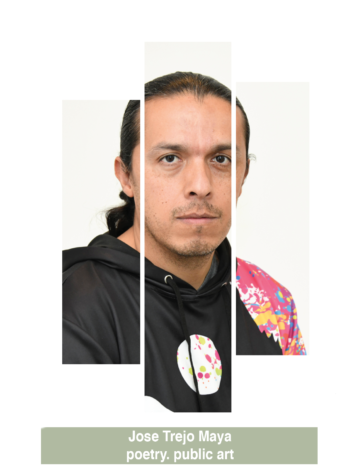 Jose Trejo Maya
Jose Trejo Maya
Baldwin Park, CA, usa
He is a remnant of the Nahuatlacah oral tradition a tonalpouhque mexica, a commoner from the lowlands from a time and place that no longer exists. Born in Celaya, Guanajuato, Mexico, where he spent his childhood in the small rural pueblo of Tarimoró and wherefrom he immigrated in 1988. His inspirations include Netzahualcoyotl, Humberto Ak’abal, Ray A. Young Bear, James Welch and Juan Rulfo. Published in various journals/sites in the UK, US, Spain, India, Australia, Argentina, Germany and Venezuela. Pushcart Prize nominee in 2015; awarded Tercer Premio from El Centro Canario Estudios Caribeños – El Atlántico – en el Certamen Internacional de Poesía “La calle que tú me das” 2016; New Rivers Press Many Voices Project Finalist 2018, 2020 Jack Straw Writers Fellow. Mozaik: Ecosystems X 2022 Future Art Awards Group Exhibition Special Mention. Exhibitions in US, Spain, Italy, South Africa, Australia, Korea, Portugal, Ukraine, Germany. Public art outdoor sculptures in WA, OR & MA. While in ceremony with Chololo medicine men in the Tule River Reservation he dreamt this written prophecy…
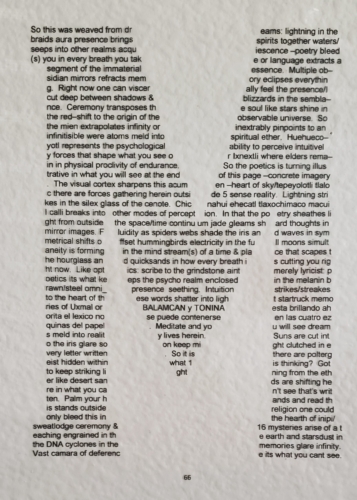
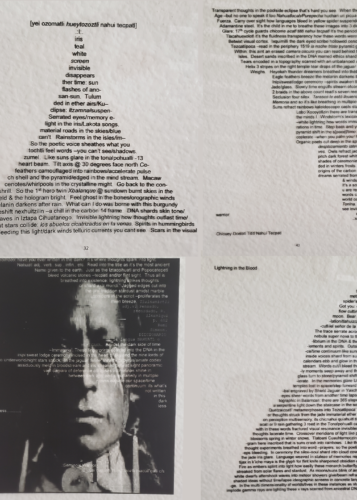
I have been exhibited in different venues with a work that’s titled: Transparencies in Time: Cuahpohualli embedded in ethnopoetic language poetry:. I seek to expand on this work into a comprehensive exhibit in a gallery and/or installation in 3D public art sculptures (i.e. three simultaneous monumental works that expand into multiple levels of perception and/or dimensions). In this the sculptures came from dreams, it’s a refraction of our ancestors so you see a mirror in yourself. I have a work in progress of a short-story series where I interpolate the sunstone calendar (i.e. the primary source of the Cauhpohualli Computo del tiempo azteca y su correlacion actual Anahuacayotl de Tlaxcalancingo, Puebla). To bring to life a micro-fiction project titled San Miguel de Tarimoro ca. 1546. It’s a micro-fiction work of short stories that delve into the immaterial aspects of time. It will be digitized into video with simultaneous audio in video-book view narration. Namely, it’s a bridge from poetry to narrative storytelling. The work is a catalog of the 365 days in the Tonalpohualli or count of days in hologram. My work is rooted in Mesoamerican lore and a pre-Columbian notion of time that’s extant in the poetics and as such it’s the foundation and bedrock.
 Jennaya Dunlap
Jennaya Dunlap
Awigna, Tongva land
(Hacienda Heights, CA, USA)
instagram.com/macheteroartcollective
Instagram: @jennaya.art
Jennaya Dunlap is a queer, neurodivergent painter, muralist and sculptor from the Los Angeles area. She is a writer and aspiring musician as well, and is currently learning the art of filmmaking. For the last few decades, she has been organizing to end immigration detention and deportations, and has seen a variety of illegal, racist and oppressive tactics used by the US government to target immigrants in Southern CA. She also supports indigenous struggles in the US and Palestine through organizing and art. Her art reflects her life’s work around social justice, often including themes of direct action, decolonization, and resistance to oppression.
Jennaya was selected for a 2023 Individual Artist Award through the California Arts Council in the Emerging Artist tier. Her work has been exhibited at Crear Studio in Santa Ana, CA, as well as online by the Art Emerge Gallery in Los Angeles. She has also been a featured artist at art festivals in Indio and Coachella. She is a member of the Machetero Art Collective, which uses muralism as a weapon to educate and organize to fight oppression.
Healing Hands
Left image: 2023. 11”x 14”. acrylic on black canvas
Here I reflect on how confronting oppression begins from within us, and part of decolonization includes reconnecting to our ancestral wisdom and practices. A maternal ancestor’s work hands weave love, wisdom, healing and ancestral knowledge into her descendants hair as she reconnects. The elements and directions are all represented, whether your own ancestral tradition is four or seven (air, water, earth and fire; east, north, west, south, above, below and within). The fir tree represents healing in the Celtic tradition, my original roots, while the abalone shell represents protection and connection to the spirit world to my ancestors.
Decolonizing Through Reconnection
Right image: 2023. 2’x 3’. watercolor on watercolor paper
This piece illustrates the power of reconnecting to our ancestors and our roots as part of the process of decolonizing. The symbolism I use is connected to my own Celtic (Scottish and Irish) ancestors and their understanding of spirituality, nature and the elements. The oak represents the connection between this world and that of the ancestors and spirits. The hawk, a symbol of guidance and a messenger from the spirit realm, is shown breaking down the destructive power of white supremacy, exposing its role in genocide and death now as in hundreds of years past. In this piece I’m addressing one of many facets of the process of decolonization– the deconstruction and destruction of whiteness as an identity. This includes actively rooting out the ways in which that identity upholds and strengthens systems, beliefs, and institutions that center whiteness (the education system, healthcare, legal system, even approaches to issues like climate change, to name a few examples out of so so many). I also believe that an essential part of deconstructing whiteness is reconnecting to ancestral practices and knowledge that were erased or abandoned to construct a settler colonialist identity.
Dr. Amber Epps:
Pittsburgh, PA (USA)
Instagram: @hollyhood156
Oscar Brown:
Somerset, PA (USA)
Oscar Brown has been incarcerated since age 19 and was sentenced to DEATH BY INCARCERATION. Once incarcerated, Oscar got involved with education. He became co-founder of the Elsinore-Bennu Think Tank for Restorative Justice, co-authored the book “Life Sentences: Writings from Inside an American Prison”, and obtained an associate’s degree from International Christian College and Seminary. Oscar also earned a drug and alcohol counselor diploma from Stratford Career Institute and became a Certified Peer Support Specialist, working with inmates who need support inside the prison. Nothing can change what happened in 2005 but every day Oscar strives to be a better person than he was when he lost his freedom. As of now Oscar seeks redemption through PA’s commutation process and hopes for a second chance one day. His work was recently featured as a part of an exhibit called “Picture a Free World”, produced by Let’s Get Free. Oscar is currently housed at SCI Laurel Highlands in Pennsylvania. Oscar’s sister, Dr. Amber Epps, is honored to collaborate with him artistically as a way to share his story with the world. In 2022, Amber received the Allegheny Arts Revival Grant from the Greater Pittsburgh Arts Council to support their work.
Caged Birds
This piece was written by Oscar and compares our incarcerated citizens to caged birds. Oscar was recorded as he read the piece during a prison phone call. The recording serves to add his voice to the photos that show him with his family throughout his life. Aside from displaying his writing, this piece serves to humanize Oscar as he is currently part of a system that views him as an animal. Video created by Amber.
This installation was part of a show entitled “Picture a Free World” hosted by Let’s Get Free in July 2023 in Pittsburgh, PA.
The installation accompanied the Caged Birds video (2023. 05:28 min). The main focal point is the bird cage that is decorated as a prison cell. Hanging in the cage are family photos and the original handwritten copy of Caged Birds. The cage also contains a bible, candle, rosary, the book that Oscar co-authored, a blanket, and feathers. Beneath the cage (not pictured) is a folded prison jumpsuit and shoes.
Caged Birds installation with video
Caged Birds video: 2023. 05:28 min. color. sound. Oscar Brown (spoken word). Dr. Amber Epps (video).
WATCH VIDEO:
 Dr. Amber Epps
Dr. Amber Epps
Pittsburgh, PA (USA)
Instagram: @hollyhood156
Dr. Amber Epps creates using various found and discarded objects from nature and other unexpected places. Inspired by spirituality, humanism, occult, social justice, and prison reform/abolition, Amber creates sculpture, installation, word art, and more. In 2022-2023, Amber’s installation, “Homage” was on display at the Pittsburgh International Airport – the first time Black/African spirituality had been presented to the public in this space. Her art was recently used for the cover of “Makeshift Altar” by Amy Alvarez.
Amber is also known as HollyHood, a hip hop artist and DJ. The video for her song “No Sleep Til Brooklyn” has appeared in a number of spaces including the McDonough Museum of Art, and the Three Rivers Arts Festival. Her album, YellowJacket, was featured in a hip-hopera she co-wrote, co-directed, and co-starred in, titled “Quest and the Girl with the Yellow Jacket”, as part of the New Hazlett Theater’s Community Supported Art series. Additionally, she has opened for artists such as Ja Rule, Warren G, GZA, Sugarhill Gang, Rakim, and KRS-One.
Amber is an author, educator, abolitionist, activist, member of the #notwhite collective, cat lover, and proud mom. Her book “mushroom logic vol 1: doves cant cry. thats stupid” is available on Amazon.
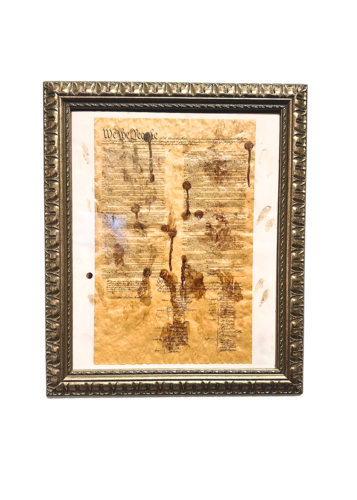
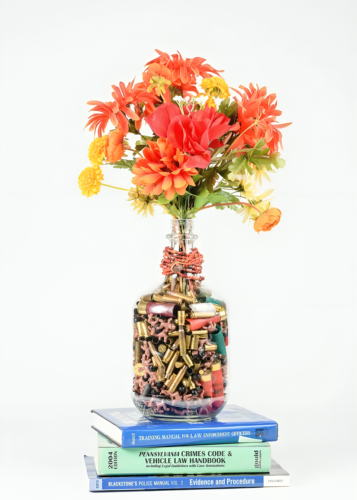
Images (from top left):
Birth of a Nation: This Land is MY Land
2021. 19”h x 18”w. Replica of Constitution and menstrual blood.
This piece represents the sweat, tears, and blood of Black and Indigenous women that built this nation. This piece represents those who have been forgotten, those whose voices were never heard, and those who lost everything in order for others to gain.
Black & Brass
2021. 22”h x 5”w. Glass jugs filled with bullet casings, police training manuals, beaded necklaces, plastic black babies, and flowers. Photo credit: Porter Loves.
This piece is part of a series that is meant to demonstrate the experiences of Black mothers who lose their children and other loved ones to gun violence at the hands of the police. The flowers and necklaces are items that are typically considered “pretty” but are an adornment on a situation that ugly and terrifying. It doesn’t matter how many flowers or jewels are present, these situations are tragedies that no mother should have to face.
Decolonization Stations
2021. 48”h x 31”L x 19”w. Vintage salon chairs, headphones, tablets.
These vintage salon chairs are equipped with headphones and a tablet. The tablets and headphones play a video that contains “subliminal” text and audio deprogramming messages. One chair is indicated that it is for #Whites Only, whereas the other is indicated that it is for #NotWhites Only, with each chair playing different messages based on the intended audience.
Title: Decolonization Station: #NotWhites Only
2021. 01:47 min. color. sound.
Music: Shade Cobain
Title: Decolonization Station: #WhitesOnly
2021. 01:45 min. color. sound.
Music: Shade Cobain
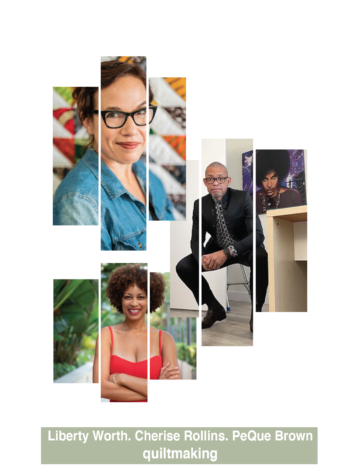 Liberty Worth
Liberty Worth
Los Angeles, CA (USA)
Instagram: @libertyworthart
Liberty Worth is an artist, quilter, teacher and poet. Graduating from Pepperdine University in Fine Art, she spent 6 years as a textile designer, continuing her art education at The Art Institute of Chicago and Art Center. A commissioned studio artist with a studio in Los Angeles, Liberty teaches high school art part-time and has a permanent installation in the Cayton Children’s Museum (Santa Monica, CA). She is the creator of “Where We Have Been & Where We Hope to Be” – a body of work inviting people to process personal narratives through the art of the quilt. Liberty is a fellow with Kipaipai (2023) and Speranza Foundation (2024) and was awarded a residency with inBreak Collective (2021), Grant Recipient for Culver City Arts District Projecting Possibilities (2020), the MidCity Los Angeles Art Lives Here award (2021) and a teaching artist position at Craft in America (2020). Liberty’s work has shown in multiple countries and her work was included in the inaugural show for the Museum of Contemporary Art of the Americas (MOCAA) in 2022. Liberty has published a book of art and poetry.
The Matriarch
(Left Image)
“What do you grieve?” was asked to a cohort of of artists in relation to the racialized events of 2020. Each participant used the same black/white triangle quilt format to tell a narrative.
The matriarch – the heart of our family …
She’s strong, motherly, loving, brave, feminine, beautiful black woman raising up the family and leads by example. She wears a crown on her head, armor on her heart, and an open mouth stretched wide because she shares her wisdom with those she loves, passing down the stories, the legacies from previous generations to the next one. Also her mouth is open because she can’t be silenced. She’s the heart of the family.
2021. 30”x 30”. cotton quilt
Liberty Worth, in collaboration with Cherise Rollins.
Part of Where We Have Been & Where We Hope to Be collaboration.
Instagram Link: @havebeenandhopetobe
The Question Is…
(Right Image)
“What do you grieve?” was asked to a cohort of artists in relation to the racialized events of 2020. Each participant used the same black/white triangle paper quilt format to tell a narrative. They created in paper and artist Liberty Worth turned 30 of them into quilts.
PeQue Brown designed this one and stated:
Never knew where I came from. I didn’t have any answers of my origins, ethnicity, or culture. All of my thoughts pointed to a question mark that was somehow inextricably wrapped around someone else’s privileges.
2021. 30”x 30”. cotton quilt
Liberty Worth, in collaboration with PeQue Brown
In collaboration with PeQue Brown.
Part of Where We Have Been & Where We Hope to Be collaboration.
Instagram Link: @havebeenandhopetobe
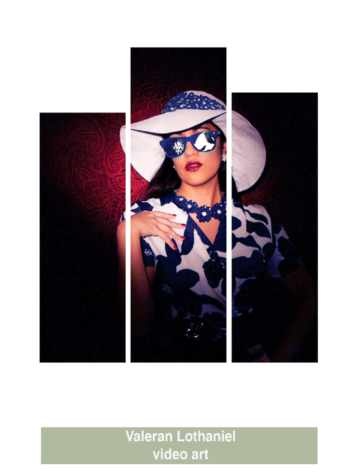 Valeran Lothaniel
Valeran Lothaniel
Palm Springs, CA (USA)
https://valeran.com
Instagram: @valeran_lothaniel
I am Valeran Lothaniel.
As an artist, I seek to celebrate my existence through the multi-disciplines of spoken word, lyrical poetry, photography and moving images. Here in my parallel worlds, I find my Prince Charming, I see my hopes and dreams realized, my unrequited love reciprocated, my immigrant experiences acknowledged. My work examines the everyday fantasies I build as escapes from the harsh realities of our real physical world. By examining and unearthing such emotions through art, I hope to facilitate learning and healing of not just myself, but of everyone who has found themselves existing in a world parallel to their own reality.
TOMATO
When I was a little girl, my mother said that my nose was like a tomato growing on my face, and that to be beautiful I had to pinch my nose so it would grow to be thin and tiny. I pinched my nose constantly. I would wear a clip on my nose to bed to keep it pinched while I slept. I pinched it until it was red and swollen, and I would bleed. My nose never became thin and beautiful. I still wish I could have the beautiful face my mother wanted me to have. This piece is a simple representation of my insecurities about my face due to my mother’s insistence that I adhere to beauty standards that were established by the Spanish upper-class in Filipino society. The idea that a woman has to be pale and thin with European features continues to affect me and other Filipina American women in subtle and direct ways, from bleaching our hair and skin, to exclusively dating Caucasian males. I’ve slowly come to accept my natural appearance, but admit that I still have a long way to go to truly be happy with who I am.
Artist: Valeran Lothaniel
Stills from the video. 2017. 02:40 mins. Color. Sound
WATCH VIDEO:
 Amirali Ghasemi & Mahoor Mirshakkak
Amirali Ghasemi & Mahoor Mirshakkak
Tehran (Iran) & Berlin (Germany)
Instagram: @amiralionly @mirahoor
Amirali Ghasemi is a media artist, designer & freelance curator based in Berlin. He has been working with text, performance, photography and video mainly, besides writing about new media art history. As a curator he is the founder of Parkingallery Project and director of New Media Society – Tehran, and Room For Doubt – Berlin. His works have been shown internationally and around Iran.
Mahoor Mirshakkak, Iranian multidisciplinary Artist & freelance filmmaker, is focused on documentary and self-collected archive. She graduated in painting from Tehran Fine Arts University. Safe & Sound (2022, Iran), and A live life of the pre-recorded (2023, France) are two of her recent solo multimedia Exhibitions. Wakeless (2014), Portrait of Ms Farrokhzad (2016), Oveis (2022), Disco (2015), La vie en vrai (2023), A moment of exposure (2024), are titles of some of her videos and films.
(Photo of Amirali by Joubeen-Mireskandari)
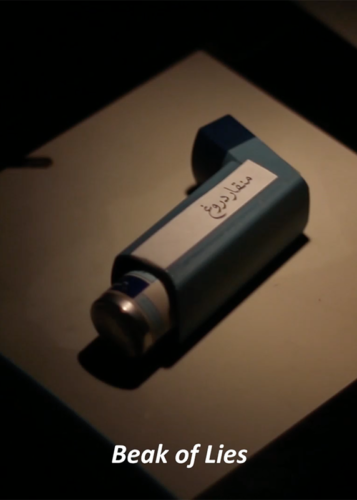
Beak of Lies
The work is based on a poem by Amirali Ghasemi.
It has been a while he has been collecting his empty asthma inhalers to visualize the poem. Mahoor Mirshakkak recorded the audio and video of the piece as Amirali re-performed the part, previously performed as a part of the ‘Burning Things’ project.
The gloomy & bizarre words emulate events surrounding us in 2020 besides the political climate that made it even worse. The calm atmosphere of the analog lab creates an immediate unbalance when the mechanical aspect of making Photograms (without papers) creates a passing moment: the words will only last for a few seconds.
Images: Video stills from Beak of Lies
Artists: Amirali Ghasemi & Mahoor Mirshakkak
2020. 06:05 mins. color. sound. Persian with English Subtitles
WATCH VIDEO:
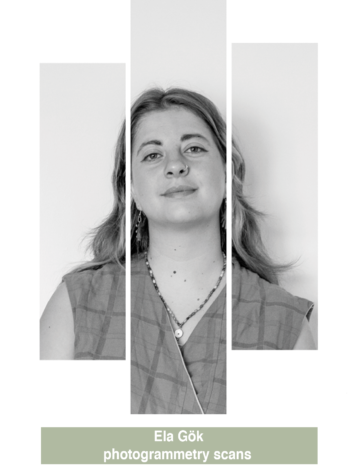 Ela Gök
Ela Gök
Istanbul (Turkey)
Instagram: @elagok95
Ela Gök is a researcher, cartographer and artist, whose work focuses on memory and spatial justice. Her investigations have explored the use of visual recordings (mapping, 3D scanning, modelling, and drawing) as tools for the translation of complex relationships involving identity, displacement, and place. In 2022 she received a research grant from the Calouste Gulbenkian Foundation to support her field research on Armenian cultural heritage sites within the Kars region of Turkey.
Images (from top left):
Churches Grown from Seeds: Eghegnamor
Rendered view from a photogrammetry scan of Eghegnamor church in northeastern Turkey. The church has seen little to no preservation efforts, suffering the same fate as the majority of churches in the region. The images for the scan have only been taken from one street where in local memory two Armenian brothers are said to have lived. As such, the scan is only partially complete, the low point count giving us only a faint outline of the church towering above the street.
Artist: Ela Gök
2023. Digital Format.
Partially funded through a grant from the Calouste Gulbenkian Foundation.
Churches Grown from Seeds: Ketchivan
Rendered view from a photogrammetry scan of Ketchivan citadel church in northeastern Turkey. The small structure is crumbing into the landscape with most of its facing stones removed. In this view a section has been cut through the scan, exposing not only the void where its roof should be but also the scars on the ground.
Artist: Ela Gök
2023. Digital Format.
Partially funded through a grant from the Calouste Gulbenkian Foundation.
Churches Grown from Seeds: Monastery of Bagnayr
The ruins of the Armenian Monastery of Bagnayr are almost unrecognisable when compared to the photographs taken of the structure before the turn of the 20th century. This image compares the plans drawn by Jean-Michel Thierry using records from the 1960s (top of image), with a photogrammetry scan of what remains on the site today (bottom of image). The scan allows us to make sense of some of the fractured ruins on the site, loosely held together stones that were once full external walls.
Artist: Ela Gök
2023. Digital Format.
Partially funded through a grant from the Calouste Gulbenkian Foundation.
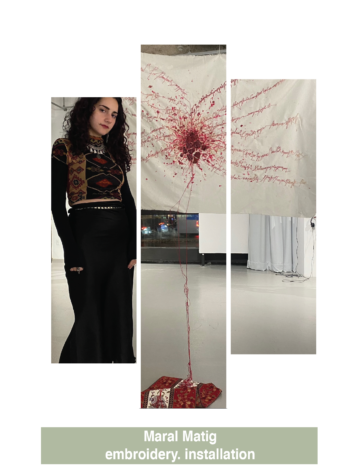 Maral Matig
Maral Matig
Montreal, Canada
Instagram: @maral.gazellig
My pieces embody the spirituality and resilience of the Indigenous Armenian people with an homage to the past and a promise for the future. Along with painting and illustration, in my practice I use traditional Armenian mediums as forms of re-connecting with diasporic longing, as well as confronting and healing my own generational trauma outside of my homeland.
At the core of my work lie carpet weaving, embroidery, and calligraphy, all of which are forms of knowledge that are being lost as a result of genocide and assimilation. My continuous engagement with these ancestral skills is an act of resistance against systems of oppression that, today, threaten the existence of my people. After the 2023 Armenian genocide in Artsakh, the land to which 120, 000 Armenians once called their homes, the birthplace for Armenian art-making is now susceptible to destruction and complete vanishment. To preserve the customs and rituals of this now occupied place means immersing myself in its creative history as an artist and designer.
Images (from top left):
Bloodlines
This tapestry lives in reverence to the spirits and survivors of the Armenian Genocide of April 24, 1915. It is a correspondence with my ancestors woven entirely in the Armenian script with thread and pomegranate on cotton. Today as the Armenians in Artsakh have faced blockade, starvation, and genocide once again, I am inclined to think about how art and self-expression can be used as tools for community healing and linguistic survival.
Artist: Maral Matig
2023. 35”x 50”. Pomegranate and thread on cotton
Weaving Home
Weaving Home bonds together traditional Palestinian Tatreez embroidery and the ancient practice of Marash stitch from the now occupied lands of Western Armenia after the first genocide of 1915, in commemoration of the second Armenian genocide that took place in Artsakh on September 19th, 2023, as well as the ongoing Palestinian genocide in Gaza. It joins the Arabic and Armenian հույս words for ‘hope’, stitched side by side in a diasporic longing for home.
Artist: Maral Matig
2023. 15”x 15”. Thread on cotton
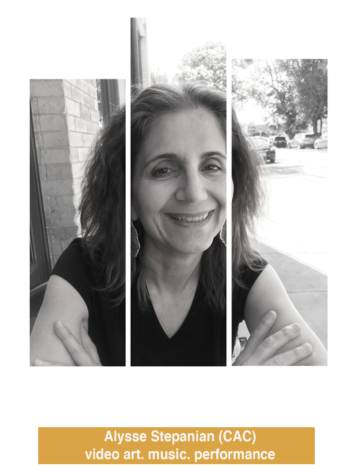 Alysse Stepanian
Alysse Stepanian
Pomo land, Turtle Island (USA)
Instagram: @alyssestepanian
Alysse is an Armenian-American, Iranian-born cross-media artist, independent curator, human and “animal” rights advocate, and Organizer of Creative Action Coalition. Her creative work, research and writings are focused on the effects of nationalism and politics of fear, and the importance of intersectionality in fighting injustices.
Stepanian has exhibited widely, and has lectured about interconnected oppressions for her co-curated exhibition of video art by 20 Iranian women, “Nietzsche Was A Man”, at the Pori Art Museum (Finland), Malmö Konsthall (Sweden), and Museo Ex Teresa Arte Actual (Mexico City). In 2018 her collaborative multimedia performance, #MemoryoftheUniverse | Bayesian Poisoning, was presented at the Instants Vidéo Numériques et Poétiques Festival in Marseille. As the BOX 1035 duo, she has created collaborative installations during residencies at Kunsthaus Tacheles/Berlin, Imagine Gallery/Beijing, and Islip Art Museum/New York.
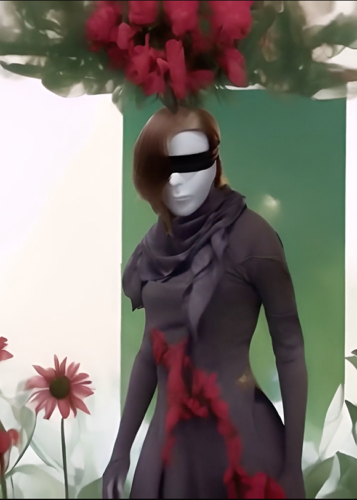
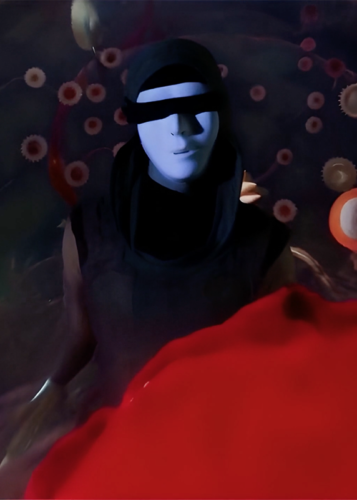
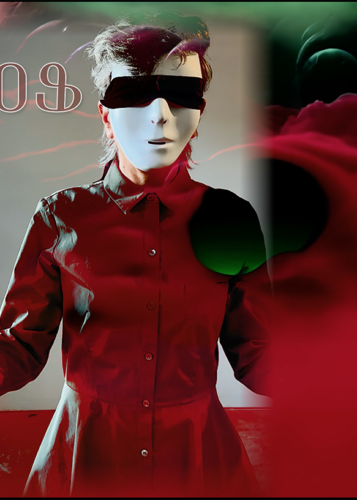
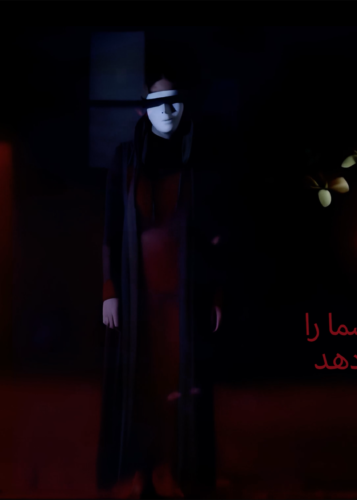
Ayb-Ben Այբ−Բեն
I live in the US, a home away from home away from home. My Armenian ancestry has not been traced beyond my great grandparents in Iran. This is a story commonly shared by those who have been forcefully displaced from their native homelands.
In this work, I embrace the digital aberrations and artifacts produced by AI technology to communicate the break-down of meaning in a world that is openly ruled by tyrants and war-profiteers. The recognition of the interconnectedness of the global struggles against oppressors and the necessity of solidarities are symbolized by the fusion of the Armenian forget-me-not flowers and Palestinian poppies. Cogs in the machine that morph into beautiful and magical flowers represent the power and potential in all of us to radically and poetically re-imagine the world and instigate change.
Images: Video stills from Ayb-Ben Այբ−Բեն
Artist: Alysse Stepanian
video art in collaboration with generative AI
2024. 06:05 mins. color. stereo
music. video. text. voice. performance: Alysse Stepanian
music producer: Philip Mantione
words and alphabet in Armenian, Persian, English
WATCH VIDEO:
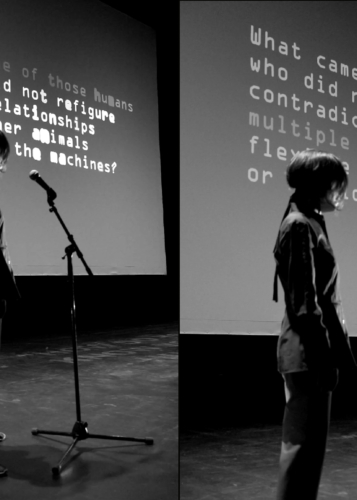
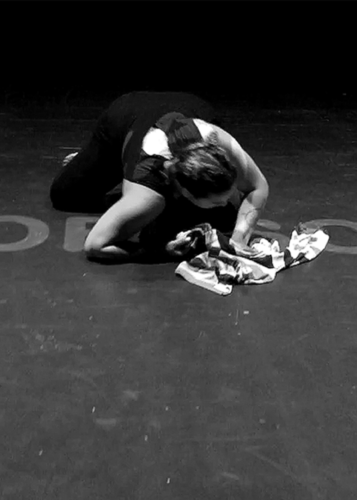
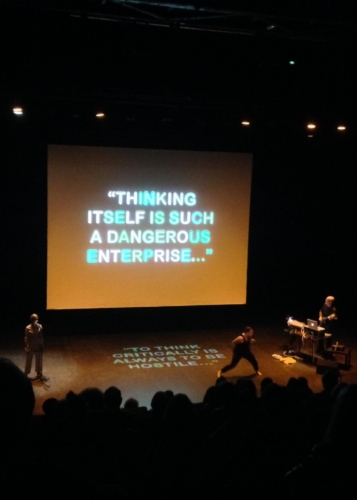
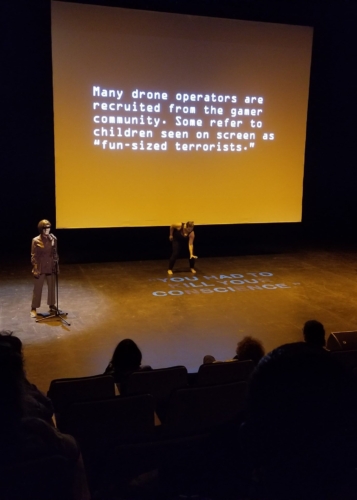
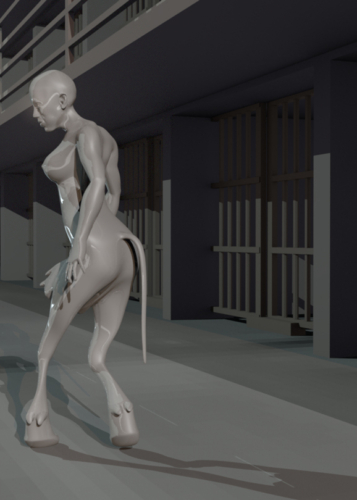
#MemoryoftheUniverse |
Bayesian Poisoning
This work incorporates Philip Mantione’s music, and Stepanian’s #MemoryoftheUniverse series of 3D animations, along with her critical analysis of American culture and politics. Choreographer and dancer, Mallory Fabian adds a powerful voice to this quirky hybrid performance that fuses art and poetry with the factual language of history.
A mythopoeic cowwoman embodying the memory of the universe, surveys the destructive human legacy from a posthuman world. Poetic and political messages are juxtaposed with personal memes that dance on the screen to the rhythm of Mantione’s music.
Alysse Stepanian: concept, research, text, 3D animations, video, performance
Philip Mantione: concept, music and sound design, guitar and live electronics
Mallory Fabian: dance, choreography
Jan Opalach: vocal samples
Performed at the 31st festival of Instants Vidéo Numériques et Poétiques, at Les Plateaux, Friche la Belle de Mai, Marseille, France.
Nov. 9, 2018. 50 mins (14 minute documentary excerpts)
WATCH VIDEO:
#MemoryoftheUniverse | Bayesian Poisoning from Alysse Stepanian on Vimeo.
 HK Zamani
HK Zamani
Los Angeles, CA (USA)
Instagram:
@hkzamani_studio
@ postlaorg
HK Zamani received his Master of Fine Arts in Painting from Claremont Graduate University. Selected regional exhibitions include Los Angeles County Museum of Art, Lancaster Museum of Art and History, A+D Museum, PRJCTLA, LA Louver, Municipal Gallery at Barnsdall. He has also exhibited nationally and internationally in New York, San Francisco, Chicago, London, Berlin, Prague, Seoul, Saigon, and Bangkok. He is a multidisciplinary artist, educator, and founder of PØST, an alternative exhibition space in Los Angeles (1995-2018), where more than five hundred exhibits were hosted. He has taught at University of California Los Angeles, University of California Santa Barbara, California State University at Long Beach, California State University at Dominguez Hills, Woodbury University, and has been a Visiting Artist at numerous national and international institutions. He is a recipient of The City of Los Angeles Individual Master Artist Project (COLA-IMAP) and California Community Foundation grants, and his work is in the collections of Los Angeles County Museum of Art, Berkeley Museum of Art, and Lancaster Museum of Art and History. Zamani’s Fashion Erasures challenge class consciousness, standardization and expectation.
(Profile photo credit: Sandeep Mukherjee)
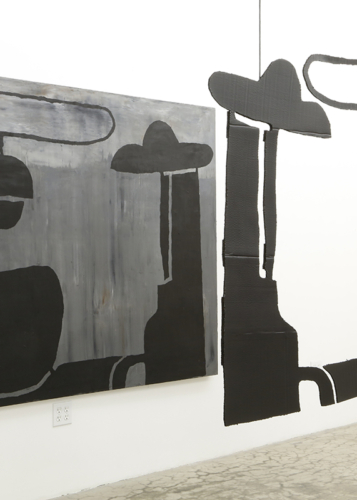
Inadvertent Protagonists
Conflating three-dimensional and two-dimensional forms is a recurring theme in Zamani’s work of the last three decades, with sculpture representing the body and painting representing the immaterial. His new works, Inadvertent Protagonists focus on the idea of coexistence in their imageries: the paintings actively converse with their sculptural counterparts. As an Iranian-American artist Zamani continues to explore his cultural duality by superimposing the values of both cultures in his work. The binary character structure of these new explorations is a preoccupation with dualities, within self or in contrast to others, and the goal of coexistence without violence.
Artist: HK Zamani
From top left:
Inadvertent Protagonists #4
2018-2021. 60” x 72”; 56” x 71” x .5”. Oil on canvas, acrylic on cardboard
Image: Inadvertent Protagonists #5
2019-2021. 60” x 72”; 52” x 72” x .5”. Oil on canvas, acrylic on cardboard
Inadvertent Protagonists #6
2019-2021. 60” x 72”; 56” x 72” x .5”. Oil on canvas, acrylic on cardboard
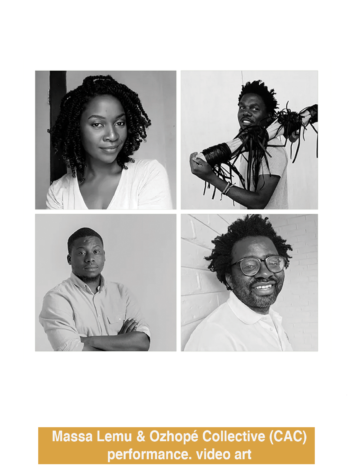 Massa Lemu (CAC Member) &
Massa Lemu (CAC Member) &
Ozhopé collective (CAC Partner)
Ella Banda, Massa Lemu, Tavwana Chirwa, Emmanuel Ngwira
(USA & Africa)
Profile image from top/left and clockwise:
Instagram: @ozhope_artcollective
Massa Lemu is a Malawian visual artist and writer whose multi-disciplinary artistic practice takes the form of drawing, performance, and multimedia installations that are concerned with the contradictions of migration within globalization and the effects of an increasingly immaterialized, flexible and mobile capitalism on the post-colonial subject. Lemu’s text-based work features techniques such as quotation and détournment to tap on the critical possibilities of the polyglot nature of communication in postcoloniality. As a writer, Lemu’s scholarly interests lie in what he calls a biopolitical collectivism in contemporary African art, i.e. a socially engaged, subject-centered, and life-forming collectivist aesthetics. His writing has been published by Third Text, the Stedelijk Studies Journal, artandeducation.net (E-Flux), Center for Contemporary Art Lagos, and Contemporaryand (C&). Lemu has a PhD (Visual Arts) from Stellenbosch University, South Africa. Lemu is the co-founder of the Ozhopé Collective, and a tenured professor in Sculpture and Extended Media at the School of the Arts at Virginia Commonwealth University. He has a PhD (Visual Arts) from Stellenbosch University, South Africa.
Ozhopé Collective (founded in 2017) is a group comprising two artists (Ella Banda and Massa Lemu [see last page]), a photo/videographer (Tavwana Chirwa), and a writer (Emmanuel Ngwira). Ozhopé’s main concern is to collaboratively produce art that inspires conversations and invites people to critical thinking around issues that affect people’s quotidian existence. The group’s name derives from the word “wosopé”, a Yao term which translates as “all of them”. The word was uttered by an enthusiastic boy in reference to the artists who were busy with their work. It was subsequently adapted to “ozhopé” whose root speaks to the collective ethos that propels the group’s collaborative practice.

Cikhara n’nali n’ndalama/If I had money
“Cikhara n’nali n’ndalama/If I had money,” engages issues of labor, displacement, migration, memory, and home through Gule Wamkulu masquerade and the Malawian fishing tradition. The mask, which is stuck on a boat on the shores of Lake Geneva, desperately paddles/dances to the Gule song whose lyrics translate as “If I had money, I would return home.” The boat, which was found on Lake Geneva, is patched using the Malawian fishers’ method of repairing their dugout canoes using metal, tar, plastic, and blankets. The fishers’ method of patching turns the dugout canoe into a beautifully textured and textual surface, carrying multiple stories of communities on the shores of Lake Malawi and of the larger Malawian society. The boat, therefore, brings into conversation Malawian stories and those of Lake Geneva/Europe to highlight the ecological, social, and political linkages between these two vastly distanced geographical locations.
Images: Video stills from Cikhara n’nali n’ndalama/If I had money
Artists: Ozhopé collective
2023. 00:55 mins. color. sound
WATCH VIDEO:
Srboohie Abajian
Glendale, CA (USA)
Instagram: @srboohie
Srboohie Abajian is an Armenian-American artist and a native of Armenia, where she earned her MFA in Painting from the National Academy of Fine Arts. Her projects focus on finding creative solutions that empower communities at risk. She uses her art as a tool to shape consciousness and effect social change.
The prestigious Puffin Foundation has supported Srboohie’s public art projects multiple times. Her work is in the permanent collections of the State Department’s “Art in Embassies” program and at the Center for the Study of Political Graphics.
Srboohie keeps expanding her practice, moving from gallery exhibitions to outdoor public spaces. Her innovative sculptures, posters, and installations reach broader audiences, who can experience art on an everyday basis. In 2023, she has focused on social-engagement in her practice, reaching marginalized communities in war-torn villages of Armenia, near the Azerbaijani border. Srboohie believes, “There is injustice in the world, and it’s up to us to try and fix that. To me, the purpose of art is to preserve and maintain humanity in the world.”
Images from left:
The Oppressed Are Always Unbreakable
This piece is dedicated to the strength and resilience of oppressed and displaced peoples, like the Armenians of Artsakh, the Palestinians of Gaza, and the Darfuri people in western Sudan. They are all victims of genocide and ethnic cleansing.
Through suffering oppression, people become stronger and more fearless. They fight and refuse to give up. Oppression generates more resistance.
The Oppressor commits atrocities out of fear. The Oppressed are always fearless.
Artist: Srboohie Abajian
2024. digital
Hold World Leaders Accountable
We live in a world where talk about genocides is suppressed. Mass murder, slaughter, colonization, and ethnic cleansing are becoming the norm. What kind of humans have we become? What kind of world do we live in?
We must keep talking and screaming about war crimes, genocide, and mass murder. Don’t let genocide become acceptable, don’t let justice fade. Keep dictators accountable and responsible for their war crimes.
Only we — ordinary people — can preserve humanity in the world. It’s our responsibility. We must demand justice and make officials accountable and responsible for the war crimes they commit.
Artist: Srboohie Abajian
2024. digital
 Zaven Ovian
Zaven Ovian
New York City (USA)
Instagram: @zavenovian @zavopoems
Zaven is a theater actor, poet, and aspiring playwright of Armenian descent.
Over the past decade, Zaven has worked in theater around New England and in New York/New Jersey, uplifting several SWANA voices in a number of his roles. His performances include Émilie (the Flea Theater), Selling Kabul (Premiere Stages at Kean), Romeo & Juliet, The Band’s Visit, and Rosencrantz and Guildenstern Are Dead (Huntington Theater), and English (SpeakEasy Stage), among others. Portraying the lives of so many SWANA communities has only added to his belief in the intersectionality our communities must work to uphold in order to free us all of racial and ethnic oppression.
His poetry and plays are inspired by the great spirituality of the Armenian people and of all peoples of West Asia, the Middle East, and North Africa, recognizing the interconnected struggle inherently attached to us through Palestine, Syria, Lebanon, Iran, Egypt, and so many other places where the Armenian diaspora has placed its roots post-genocide.
The lack of representation for the Armenian community in theater results in almost no roles for any Armenian actors to portray. Therefore, he says “we must write our own stories so that we can have an accurate representation and equal opportunity to finally play ourselves onstage. It’s time the world met the incredible resolve of the Armenian people and the incredible theatrical talent we have to offer.” He is a proud descendant of Armenian Genocide survivors.
Poetry by Zaven Ovian.
Images (from top left) courtesy of the artist.
“Consider Us, 1 & 2”
“Consider Us” was written based on the destroyed mulberry orchards of Artsakh and the destroyed olive groves of Palestine. The text is shaped to visually represent the trees while the words themselves speak to each community affected by their removal: Armenians and Palestinians. It shows us how our people not only cultivate the land and its crops in the face of danger but are forever bound within their growth and survive through their existence. Their removal is another act of cultural genocide.
After Najwan Darwish’s “Who Remembers the Armenians?”
Poem by Zaven Ovian in response to Palestinian poet, Najwan Darwish’s “Who Remembers the Armenians?” (included in the slide show, following Zaven’s poem).
“Their Stories”
“Their Stories” was written late into the evening I discovered the death of Refaat Alareer. I reread “If I Must Die” several times that night. This poem is a call to earn the sacrifice so many gave so that we may live a life they couldn’t, and to remember them and tell their stories not only of resistance, but as ordinary people who one day hope to mourn their loved ones not from above rubble, but next to their bed as they leave this world of old age and long, happy lives.
“Memory Unknown”
This poem expresses an imagined life where my parents’ families had never been chased away from their lands. My father, whose family owned and worked in salt mine in Keghi, Erzurum, talks fondly of the hard work they put into their land. As for my mother – a beautiful soprano who sings every Sunday in the Badarak – it is my wish to have heard her voice fill the halls of our ancient churches of Van, where her family escaped. It is a sad but lucky life I have to imagine these unrealized desires.
